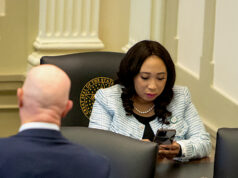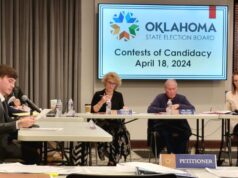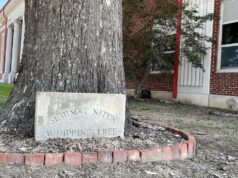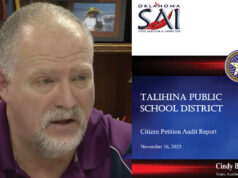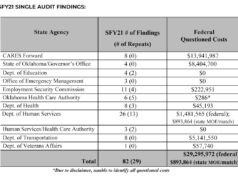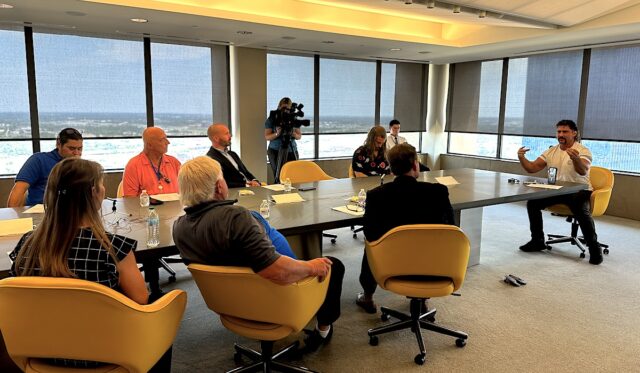

As the days of summer roll by, those distracted by vacations, the presidential sweepstakes or preparations for the Olympics might accidentally overlook various events going on in Oklahoma.
To that end, slap fighting could someday be coming to a venue near you, an election about a new Norman arena proposal won’t be coming as soon as some thought, and a state agency has contributed a record total amount of funding to public schools, colleges and universities.
Find updates and details about those matters and more in the roundup below.
Athletic Commission seeks AG opinion, discusses professional wrestling gender rule
The Oklahoma State Athletic Commission met for its quarterly meeting July 10 to consider changing a gender rule that applies to professional wrestling and to consider allowing slap fighting in the state.
The meeting came as professional wrestlers have been complaining about a prohibition against men and women competing in the same match together and as slap fighting has gained national attention. The OSAC recently issued a warning to a wrestling company after it hosted an event with a transgender wrestler.
“I think the whole thing of Oklahoma regulating professional wrestling is absurd and should be done away with completely,” professional wrestler Brandon Groom after the July 10 meeting. “Male versus female is totally safe. Going through a table — if a wrestler knows how and chooses to — is totally safe. Being thrown on the floor is totally safe.”
Groom spoke to nine-member, governor-appointed Athletic Commission during the meeting’s public comment portion to urge them to eliminate current rules that prohibit men and women from competing in professional wrestling matches together. Groom emphasized that all matches are choreographed by professionals and said there is very little risk involved when wrestlers know what they are doing.
Commissioners seemed interested in exploring a rule change but were told by their legal counsel, Assistant Attorney General Mackenzie Hill, that rulemaking happens later in the year.
“It would be too early — as of right now — to begin the rulemaking process, but that’s always an option for you guys to consider,” Hill said during the meeting.
Commissioners also discussed allowing slap fighting competitions in the state. A relatively recent phenomenon, slap fighting competitions involve two contestants standing feet apart and slapping each other until one person gets knocked out or the round concludes. Although the competitions have gained notoriety online, many have called them inherently unsafe.
“You’re striking your opponent without the opponent doing anything to protect themselves, and so I think when you do that, I think you actually take the sport out of it,” said Chairman Mike Bower, “Where’s the sport? It’s not like you’re blocking the blow or anything like that. You’re basically just trying to show that you can sustain being hit by an opponent without any protection. And so, I’ve got some concerns. One of our No. 1 responsibilities is the safety of the fighters.”
Athletic Commission members opted to not take action on allowing slap fighting in the state and instead voted to request an attorney general opinion on whether the commission has the regulatory authority to make rules for slap fighting.
Although commission members seemed open to discuss the issues with media after the July 10 meeting, they were prevented from doing so by Hill, the assistant attorney general. While Bower agreed to an interview with reporters, Hill intervened sand said commission members were not allowed to talk to journalists. Bower then declined to be interviewed.
Leslie Berger, press secretary for Attorney General Gentner Drummond, emailed a statement about Hill’s intervention in response to a question from NonDoc.
“OAG counsel routinely make recommendations to board members and commissioners regarding interactions with the press about legal matters,” Berger said. “Recommendations vary on a case by case basis, and are not binding upon individual board members or commissioners.”
Troubled OKC pedestrian bridge closed again

Oklahoma City’s $5.3 million pedestrian bridge that spans Northwest Expressway and connects Lake Overholser with Lake Hefner via the city’s trail system is closed. Located just west of MacArthur Boulevard where Wilshire Boulevard and Brookside Drive intersect with Northwest Expressway, the bridge has become something of a boondoggle for the city.
Construction began in 2021, and the bridge opened a year late, in June 2023, owing to supply issues with some components during the height of the COVID-19 pandemic.
When it finally opened to pedestrians, problems arose almost immediately. It turns out the bridge is not in compliance with the American Disabilities Act, a flaw that was not caught during the bridge’s lengthy design and construction phases. Repairs began earlier this month, and the bridge is expected to be closed through at least early August, according to OKC officials.
Balkman boots non-binding Norman arena vote — for now

(Editor’s note: At 8:15 p.m. Monday, July 29, this section was updated to reflect a joint dismissal filed by the parties in the lawsuit described below. Some details have been updated to reflect the joint dismissal.)
As residents and stakeholders wait for details about the proposed development of a new basketball, gymnastics and multi-purpose arena on the north side of Norman, a non-binding election called by the Norman City Council has been cancelled after a legal challenge that was jointly dismissed Monday, July 29.
After hearing arguments July 11, Cleveland County District Court Judge Thad Balkman issued an order canceling the Aug. 27 election, which the Norman City Council approved by a 6-3 vote June 11.
The election would have asked Norman residents whether they support a proposed 25-year Tax Increment Finance district in the University North Park. Even had it been held and had opponents of the project prevailed, the election would not have prohibited the Norman City Council from approving the TIF district, which proposes collecting and redirecting up to $600 million of future sales tax and property tax collections in the area to pay off bonds needed to build the arena, commercial storefronts and residential developments.
The new arena has been sought for a decade by the University of Oklahoma, which would pay an undetermined amount of rent to whatever entity — public or private — ends up owning the facility. OU officials believe a modern arena located closer to the Oklahoma City metro area would boost its basketball programs, but some Norman residents fear the TIF proposal will become a financial drag on the city and question why formal details have been lacking.
Filed by former Norman Mayors Bill nations and Dick Reynolds, the lawsuit challenging the legality of a non-binding election argued that the City Council’s attempt to place the proposition on a ballot “is inconsistent with the requirements of state law.” Attorneys for the plaintiffs argued that the proper way for Norman residents to vote on a TIF district would be for the City Council to authorize the TIF and for residents to collect enough signatures to trigger a referendum election on the proposal.
In their joint dismissal filed July 29, the city and the plaintiffs stipulated that, after reviewing statutory and municipal deadlines, they came “to the mutual understanding that the special municipal election called for by Council Resolution No. 2324-150 procedurally cannot be held on the originally contemplated Aug. 27, 2024, or the next legally permissible municipal election date thereafter, Nov. 5, 2024.”
With the non-binding election proposal now “moot,” it is unclear whether the Norman City Council could consider some other resolution or mechanism by which citizens would vote on the arena development topic.
On July 11, Balkman had said the broader legal question deserved full consideration. As a result, he entered a temporary restraining order canceling the Aug. 27 election to prevent the printing of ballots, which would have had to occur by July 12 to meet federal notification laws for overseas and military absentee voters.
“I am not making a decision based on the merits of whether or not there should be an advisory vote at all. The question is whether or not there should be an advisory vote that takes place Tuesday, Aug. 27, and whether there should be a restraining order entered to prevent that from happening,” Balkman said July 11. “The plaintiffs have met their burden for showing that there is a likeliness that they could succeed on the merits of their claim. I believe there has been sufficient evidence shown that the setting of the election date was legally infirm. And when you look at the balancing of the harm caused by either side, I think that weighs in favor of the plaintiffs.”
After the hearing, attorneys representing the OU Foundation — which owns the University North Park property — said they would have a communications professional contact NonDoc to answer questions about the arena proposal, but that did not occur.
CLO distributes record funds to public schools, higher education
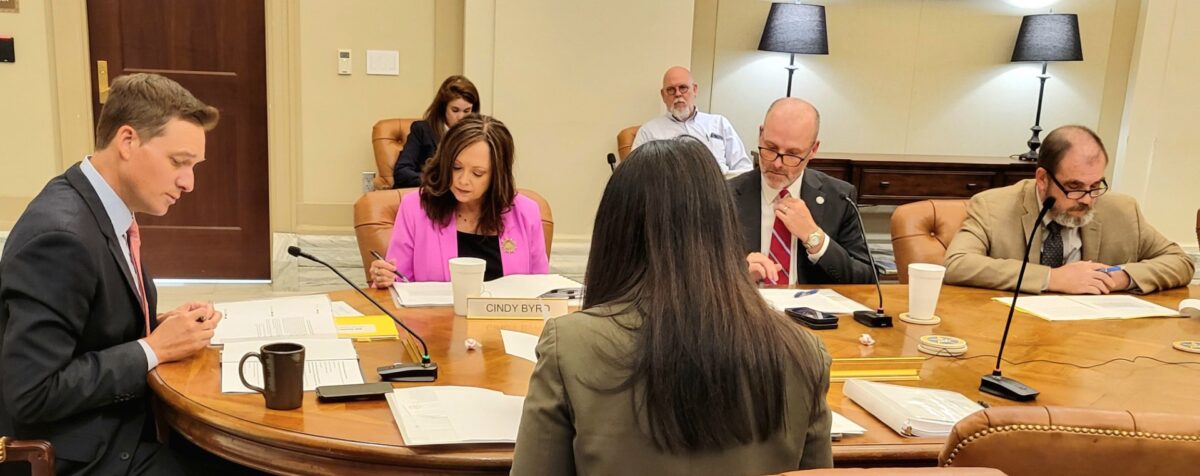
The Oklahoma Commissioners of the Land Office contributed a record total amount of funding to public schools, colleges and universities in the state during the recently completed Fiscal Year 2024, breaking the high mark set 12 years ago.
The Land Office contributed $145.2 million during FY 2024, which ended June 30. Of that amount, $103.3 million was distributed to public school districts, and $41.2 million was distributed to colleges and universities. Dan Whitmarsh, the secretary who leads the Commissioners of the Land Office, briefed commissioners on the numbers during their meeting July 11.
The amount tops the previous high contribution of $140.6 million during FY 2012 when $102.1 million was contributed to public schools and $38.5 million was distributed to colleges and universities, according to CLO figures. The FY 2024 total and the amount distributed to higher education are record highs. The amount sent to public schools marks the third highest behind $103.4 million distributions in both the FY 2017 and FY 2018.
The Commissioners of the Land Office has leased and managed surface and mineral interests for millions of acres of land dating back to statehood for the benefit of public schools and higher education institutions. Last year, the CLO contributed $129.4 million to education: $96.1 million to public schools and $33.3 million to higher education.
“A lot of that comes from our big permanent fund that we have, which is a $2.7 billion permanent fund investment fund,” Whitmarsh said.
Dividends and interest on the trust — which is approaching $2.8 billion — generated about $110 million this past fiscal year, he said. The agency also benefits from auctions on minerals and land auctions, as well as revenues from commercial properties accumulated over the years, often by land swaps as part of other economic development projects in Oklahoma.
Currently, the CLO controls about 1.1 million mineral acres and 726,000 surface acres, which includes commercial real estate. The CLO has 30 investment real estate properties with a fair market value of $144.2 million, said Tristan Newbold, the agency’s director of legislative affairs and public relations.
The Land Office’s only purpose is to manage that property, which was set aside to support public education in Oklahoma. Article 11, Section 2 of the Oklahoma Constitution mandates that all money the agency raises be spent on public education.
That money is handed out in monthly distributions to school districts and higher education institutions. A total of 13 colleges and universities receive funding from the office. Typically, about 70 percent of the funding goes to common education, with the remaining 30 percent going to higher education.
During the 2024 fiscal year, the University of Oklahoma received $10.9 million, Oklahoma State University received $9.2 million, Northern Oklahoma College received $3.8 million and Langton University received $2.2 million. Other universities and colleges each received about $1.2 million.
Among public schools, Oklahoma City Public Schools received $5.25 million and Tulsa Public Schools received $5.18 million. Other school districts receiving at least $2 million were: Edmond, $4.4 million; Moore, $4.1 million; Broken Arrow, $3.3 million; Norman, $2.6 million; Lawton, $2.4 million; Mustang, $2.3 million; Jenks, $2.1 million; and Midwest City-Del City, $2 million.
Ethics Commission reviewing task force report on campaign finances
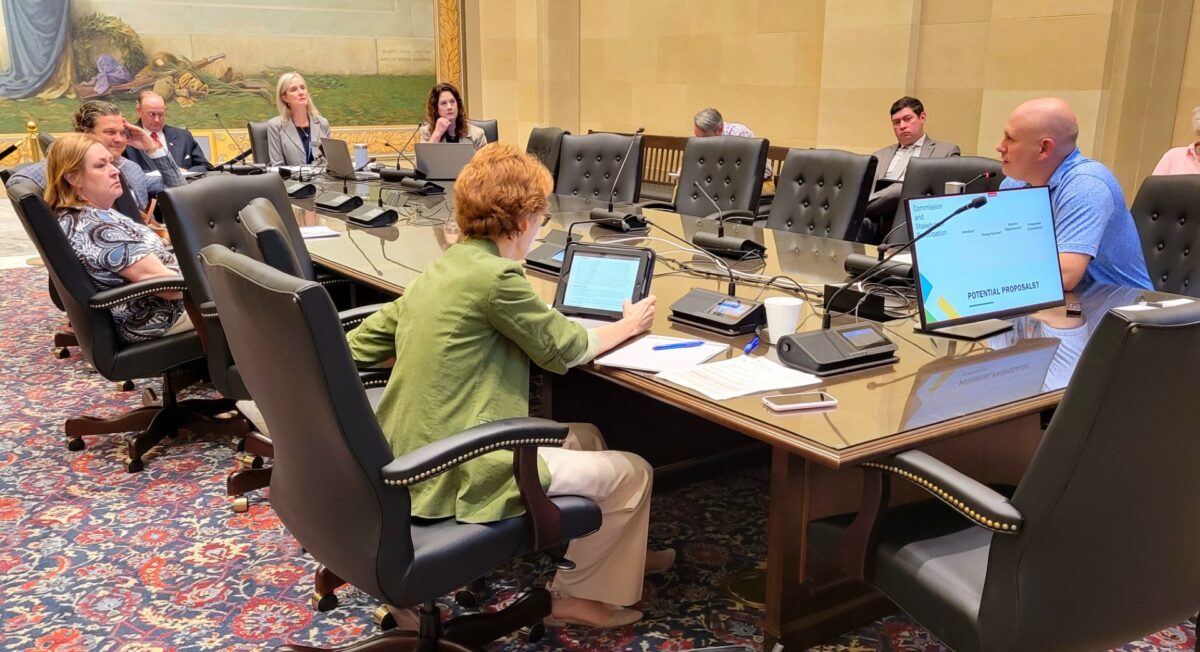
The final report of a campaign finance task force created by Gov. Kevin Stitt — which includes a recommendation for eliminating limits on how much money candidates can accept from individuals — is being reviewed by the Oklahoma Ethics Commission.
Commissioners have held two of three working group sessions, in which a quorum of the five-member Ethics Commission is not present, to look at recommendations directed specifically at the commission.
The working group sessions have discussed concerns about coordination between campaigns and independent expenditures, which are supposed to have no connection to candidates for office. A third session looked at cumulative reporting thresholds.
In November, Stitt issued an executive order creating the Governor’s Task Force on Campaign Finance and Election Threats to look into whether foreign investment and interference was affecting Oklahoma elections. The task force also was directed to review how campaigns are financed and regulated in Oklahoma.
About 15 people turned out July 11 at the State Capitol to attend the Ethics Commission’s working group session on independent expenditures, which have ballooned nationwide since the U.S. Supreme Court’s 2010 ruling in Citizens United v. Federal Election Commission.
“Candidates, not independent expenditures, should run races. (…) Candidates and the political parties that support them are not currently allowed under Oklahoma law to effectively compete against independent expenditures,” the task force wrote in its March 31 report. “Independent expenditure entities are allowed to raise anonymously unlimited amounts of money where candidates and political parties may not.”
Currently, a candidate can accept $3,300 per individual per election in Oklahoma. In practice, that means a candidate could receive up to $9,900 from one person if the candidate appears on the ballot in a primary, a runoff and the general election.
Attorney A.J. Ferate, a former Oklahoma Republican Party chairman who chaired the governor’s task force, spoke before an Ethics Commission working group session on independent expenditures. He said change is needed to combat the impact of independent expenditures, which can support or oppose candidates while often hiding the sources of their financing.
In Oklahoma’s last statewide election cycle of 2022, independent expenditures significantly outpaced contributions made to candidate committees, Ferate said.
Ferate specifically discussed the governor’s race that saw Stitt prevail despite massive third-party opposition.
“Independent expenditures had a 4-to-1 spending advantage against the candidate that was opposed,” Ferate said, noting that Stitt’s campaign complained that dark money groups had spent more than $50 million to oppose him. Stitt reported spending more than $10 million on his reelection effort.
Former State Rep. Mike Wilt has been appointed to the Oklahoma Ethics Commission. Wilt (R-Bartlesville) served in the Oklahoma House 1996 to 2006. He was appointed by Senate President Pro Tempore Greg Treat (R-OKC) to a five-year term. He succeeds Gregg Engle, whose term expired July 1.
Ferate also mentioned the 2022 race for state auditor and inspector where two independent expenditure groups, or political action committees, spent more than $500,000 in support of political newcomer Steve McQuillen in the Republican primary. McQuillen reported spending less than $2,500. State Auditor and Inspector Cindy Byrd won reelection despite the PACs’ massive spending in support of McQuillen, and the money was ultimately connected to Epic Youth Services owners Ben Harris and David Chaney, who were subsequently charged with a slate of felonies in a case that remains ongoing.
“We don’t know who these individuals are in many instances. We have guesses of who they might be, but we don’t know where the money is coming from in a lot of these instances,” Ferate said, referencing the Citizens United ruling and other court precedents. “Unless you get the Supreme Court to take away a series of cases — not just going back to Citizens United but going all the way back to the ‘70s — the concept of independent expenditures cannot be removed from our constitutional First Amendment rights.”
Fewer than a dozen states place no limits on individual donations, according to the National Conference of State Legislatures. Any change in Oklahoma would require action by the Ethics Commission.
“We’re already starting to see it in not only in Oklahoma but in other states where, if I’m running for statewide office, why do I even waste my time hiring staff?” Ferate said. “I just take one of my trusted advisers and say, ‘Go, run an independent expenditure for me.’ Millions of dollars are raised in there, and I just sit back and let the messaging be done through them.
‘We need to be able to hold the candidates responsible for the message, because we certainly don’t have the ability to hold independent expenditures accountable for what they are doing.”
Turnpike Authority awards final cable barrier project
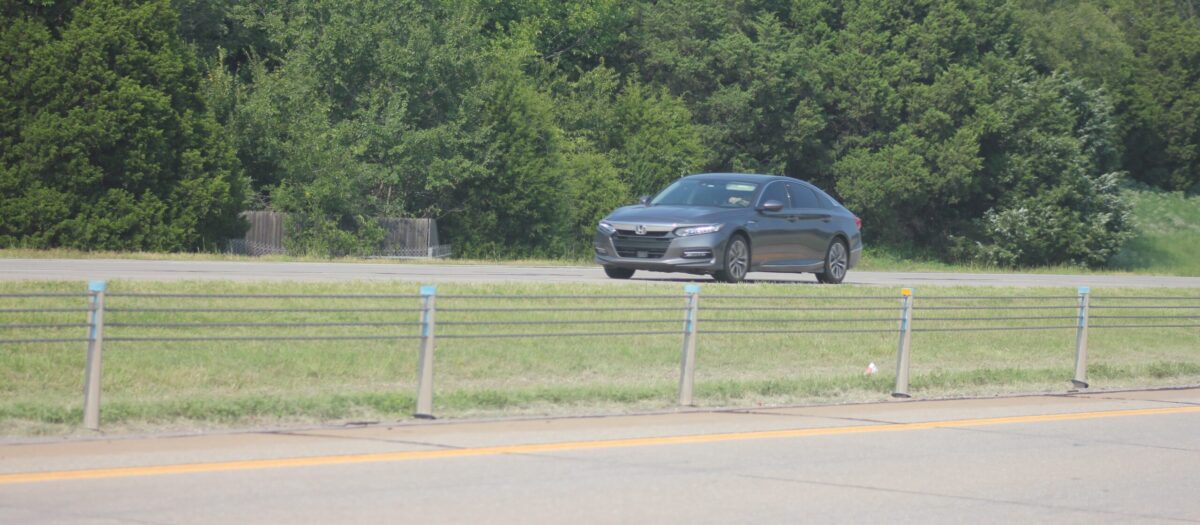
A 13-year effort to install cable barriers on the Oklahoma Turnpike Authority system is nearing completion.
During a July 9 meeting, the OTA’s board awarded a contract to install a 10-mile stretch of cable barriers in the median of the Indian Nation Turnpike from Mile Post 52 to Mile Post 63 near McAlester in Pittsburg County. The $11.7 million bid was awarded to Built Right Construction, which submitted the lowest bid. Seven other bids were submitted.
The contract represents the final 10 miles of cable barrier installation to complete all 311 miles that needed barriers on Oklahoma’s turnpike system, OTA executive director Joe Echelle told board members. When a vehicle veers left off of the road, cable barriers capture or redirect it and prevent it from crossing over to the opposite lane of traffic. Cables are considered safer than less-forgiving concrete barriers, and they cost about one-fourth of the price.
Ten years before the OTA began installing cable barriers, the Oklahoma Department of Transportation became the first in the nation to install cable barriers in 2001 on Hefner Parkway in Oklahoma City. Before installing cable barriers, the OTA exclusively used concrete barriers, which will remain in place on the Will Rogers, Turner and Muskogee turnpikes and on the W.E. Bailey Turnpike from Oklahoma City to Lawton. The 13-mile long Chickasaw Turnpike, which runs from near Ada to west of Sulphur, lacks barriers because it is a two-lane roadway with no median.
The Indian Nation Turnpike bid awarded this month is the 25th project as part of an initiative that began in 2011, with construction starting in 2013, Echelle said. The final project is expected to start by October with estimated completion by next summer.
Overall, OTA has spent $110 million to install cable barriers, Echelle said, marking the most significant safety improvement undertaken in recent turnpike history. Cable barriers were completed on the Cherokee Turnpike in May. A project to install cable barriers in the median of the Cimarron Turnpike is scheduled to be completed this fall.
Since the OTA began installing cable barriers, Echelle said they have been struck more than 2,600 times.
“It has saved numerous lives and been a tremendous asset for us in that the accidents that do occur are usually minor,” he said. “Most of the time, somebody gets into the cable, they’re able to keep driving. And the ones where it is a major accident and they’re stuck there, we’re able to collect on insurance. All of those expenses to repair cable barrier or replace posts, those aren’t always on us. Sometimes we are able to collect those from insurance.”
Board members voted 6-0 to approve the last cable barrier project.
“There’s no question it saves lives,” board member Gene Love said.








